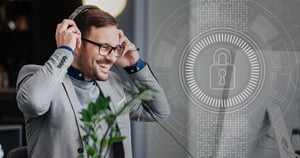
Videoconferencing and the Rising Cybersecurity Concerns
Everyone is talking about videoconferencing and cybersecurity. The COVID-19 pandemic has fundamentally changed our work and accelerated the megatrend towards a digital workspace. Governments and employers force millions to set up home offices and work remotely. Likewise, video conferencing became the most critical enabler in keeping teams and enterprises operational during these unpredictable times. However, the growing use of what used to be an emerging technology has brought up some serious concerns. Not without reason is the hashtag #zoombombing currently trending on social media. While "zoombombing" can sometimes be quite funny, other examples show the opposite truth. Pornography injected into school meetings or the hacking of a virtual synagogue to display Nazi memes are a few of the terrifying examples.
Video conferencing providers make it relatively easy for hackers to jump on your video meeting
Even in 2020, video conferencing providers such as Zoom are making it relatively easy for hackers. It is no rocket science to access live video feeds from others. Besides the rise of hacked installers carrying malware, the discussion around Boris Johnson's Tweet about his first digital cabinet raised serious cybersecurity concerns. The UK Prime Minister's post showed the meeting ID number and the usernames of some ministers participating.
While Downing Street insisted Johnson's communications are secure, security experts say that in a worst-case scenario, the following could happen: The meeting ID could be reused, and if a password does not protect the meeting, an eavesdropper could easily join. This has prompted the UK Ministry of Defence and National Cybersecurity Centre to investigate. At the same time, New York's attorney general has raised concerns about whether Zoom can securely handle the quick rise in usage. Elon Musk's SpaceX has gone beyond that, banning Zoom usage altogether.
Video conferencing cybersecurity: The importance of adhering to the rules
Despite previously published vulnerabilities from 2019 and early 2020 that can compromise your Windows system and private data leaks, Zoom can be used securely, provided that users adhere to the rules strictly and use an ideal setup. At Eyeson, we are going a very different way. We are touting videoconferencing cybersecurity through the design of an important feature, thereby drastically reducing how users can inadvertently expose their communications. One example is that no meeting ID is shown. Eyeson is strictly browser-based and doesn't require any installation or plug-in. The quick-join feature allows the host to invite guests through a unique and cryptic guest link. We randomly generate this link in that exact moment, ensuring that it expires right after the meeting.
Eyeson offers advanced videoconferencing cybersecurity features
We have previously written about the reasons why you should switch to Eyeson. One of the main reasons is that we provide advanced security features such as dynamically created quick join links. The links are safe because they are disposable and for one-time usage only. Another advanced feature is the ability to lock rooms. Locking a room can prevent uninvited participants from entering or eavesdropping. The locking feature also prevents users from re-entering without an active invitation. Users who have previously been part of the meeting cannot rejoin without a quick join link.
Already using Eyeson and want to find out how to have a super safe video meeting? Here is our help center article with quick instructions.